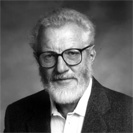

Professor
Herbert Kroemer
2000 Nobel Physics Laureate
ECE Department and Materials
Department
2205A Engineering Science Building
Electrical and Computer Engineering
University of California
Santa Barbara, CA 93106-9560
Ph: 805 893-3078
Fax: 805 893-7990
Bio: Professor Kroemer received a Ph.D. in Theoretical Physics in 1952 from the University of Göttingen, Germany, with a dissertation on hot-electron effects in the then-new transistor, setting the stage for a career in research on the physics and technology of semiconductors and semiconductor devices. Following work in several research laboratories in Germany and the USA, Kroemer persuaded the ECE Department at UCSB in 1976 to put the limited resources it had available for expanding their small semiconductor research program, not into mainstream silicon technology, but into the emerging compound semiconductor technology. In this field, Kroemer saw an opportunity for UCSB to become one of the leading institutions. He himself became the first member of the group, thus founding what has grown into a large group that is second to none in the physics and technology of compound semiconductors and devices based on them.
In his research. Prof. Kroemer has always preferred to work on problems that are one or two generation ahead of established mainstream technology. In the mid-‘50s, he was the first to point out that great performance advantages could be gained in various semiconductor devices by incorporating what is now called heterostructures into the devices [1]. Most notably, in 1963 he proposed the concept of the double-heterostructure laser, the central concept in the field of semiconductor lasers, without which that field would simply not exist [2, 3]. These ideas were far ahead of their time, and required the development of modern epitaxial growth technology before they could become mainstream technologies, in turn providing a great stimulus towards the development of these technologies. Kroemer’s receiving the Physics Nobel Prize in 2000 can ultimately be traced to these early papers. Only by 1980 had the technology progressed to the point that the 80’s became a decade of “Heterostructures for Everything [5]”— a topic that continues to dominate compound semiconductors—not just lasers and light-emitting diodes, but integrated circuits as well [6]—and is even invading mainstream silicon integrated circuit technology.
Parallel to his work on heterostructures, Kroemer pursued the problem of high-field electron transport, especially negative-resistance effects such as the Gunn effect [4], and the crucial enabling role of non-trivial energy band structure in such effects.
Upon coming to UCSB, Kroemer turned to experimental work and became one of the early pioneers in molecular beam epitaxy, concentrating from the outset on applying the technology to untried new materials systems, such as GaP and GaAs on silicon. In 1985, his work shifted towards the “6.1Å group” of materials, InAs, GaSb, and AlSb, a group where he saw great opportunities for basic research as well as for future devices. One intensively studied research area involved superconductor-semiconductor hybrid structures where InAs-AlSb quantum wells are contacted by superconducting niobium electrodes, which induce superconductivity in the semiconductor [7,8]. Another area involved electron transport in semiconductor superlattices under sufficiently strong electric fields that the electrons undergo oscillations within the tilted energy bands. Such structures might be capable of serving as oscillators—commonly called Bloch oscillators—up to frequencies in the terahertz regime [9].
Since the late 1990s, Kroemer has reverted to purely theoretical work, some of which continues earlier work [8,9,12], some is in newer research areas, like electromagnetic wave propagation in photonic crystals, especially negative-refraction effects, as well as the physics of nanostructures.
Professor Kroemer has received numerous national and international honors and awards for his work, most recently-and most notably-the 2000 Nobel Prize in Physics "for developing semiconductor heterostructures used in high-speed- and opto-electronics," (View Ceremonies) and the 2002 IEEE Medal of Honor "for contributions to high-frequency transistors, and hot-electron devices, especially heterostructure devices from heterostructure bipolar transistors to lasers, and their molecular beam epitaxy technology." He holds honorary doctorates from the Technical University of Aachen (Germany; 1985), the University of Lund (Sweden; 1998), and the University of Colorado (USA; 2001). In 2001, he received the Grand Cross of the Order of Merit of the Federal Republic of Germany, the highest award given by the German government. He is a member of both the National Academy of Engineering and the National Academy of Sciences.